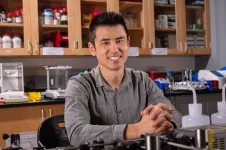(Press-News.org) The ability to dynamically track the movement of cells is essential for modeling cellular interactions as they form organs such as the heart. But current microscope technology isn’t up to the task of capturing those movements.
Juhyun Lee, associate professor in the Bioengineering Department at The University of Texas at Arlington, recently received a five-year, $1.94 million grant from the National Institutes of Health to develop a 4D high-resolution imaging system to quantify cell tracking.
Traditional microscopes allow users to zoom in to view an individual cell. However, doing so obscures that cell’s relationship to everything around it. Likewise, when the microscope is zoomed out to view the full field, the cell details are no longer visible.
Lee’s system will use microscopy and advanced computational post-processing to provide the next generation of imaging tools for biomedical researchers. His high-resolution microscope will zoom in and sweep left and right to scan an entire field of view. Those images will be stitched together to show a complete view, and an additional scan will create a 3D model.
“We are trying to quantify where each cell will go as the heart develops. The whole idea of this tool is to enable us to see the whole picture in high resolution,” Lee said. “Cells that form organs with dynamic motion, like the heart, are fast-moving. Using methods based on the motion and orientation of a cell, we can predict where it will go.”
Lee’s research has focused on how the heart develops, and he has received multiple previous grants focused on developing a new microscope that can capture 3D motion and add time. With this, he can construct a 4D beating heart using optical imaging techniques with fluorescent nanoparticles in a zebrafish. It is this microscope that will be used in his new grant.
Developmental biologists could eventually use Lee’s system to predict early cell development, making it valuable for detecting possible anomalies.
“The integration of technology and biology is a constant goal in the biomedical engineering field, and Dr. Lee’s work to develop imaging systems that can assist in our knowledge of cell activity and development is at the forefront of that effort,” said Michael Cho, the Alfred R. Potvin and Janet H. Potvin Endowed Chair in Bioengineering.
Written by Jeremy Agor, College of Engineering
END
A microscope that can monitor the development of the heart
UTA bioengineer developing high-resolution imaging system to quantify cell tracking
2023-10-30
ELSE PRESS RELEASES FROM THIS DATE:
A Google Slides extension can make presentation software more accessible for blind users
2023-10-30
Screen readers, which convert digital text to audio, can make computers more accessible to many disabled users — including those who are blind, low vision or dyslexic. Yet slideshow software, such as Microsoft PowerPoint and Google Slides, isn’t designed to make screen reader output coherent. Such programs typically rely on Z-order — which follows the way objects are layered on a slide — when a screen reader navigates through the contents. Since the Z-order doesn’t adequately convey how a slide is laid out in two-dimensional space, slideshow software can be inaccessible to people with disabilities.
A team led by researchers ...
Prisons vulnerable to natural disasters, but ill-prepared
2023-10-30
Three-quarters of Colorado prisons are likely to experience a natural disaster in the coming years, but due to aging infrastructure and outdated policies, many are ill-equipped to keep residents safe, suggests new CU Boulder research.
The study, published in the journal Natural Hazards Review, comes on the heels of one of the hottest summers on record and as U.S. lawmakers are calling for an investigation into a rash of what are believed to be heat-related deaths in the nation’s prisons.
In other research, including interviews and focus groups with 35 formerly incarcerated Coloradans, the researchers found that most had already suffered from climate-related hazards, experiencing ...
Virtual cognitively enhanced tai chi program improves cognition and executive function in older adults with mild cognitive impairment
2023-10-30
Embargoed for release until 5:00 p.m. ET on Monday 30 October 2023
Annals of Internal Medicine Tip Sheet
@Annalsofim
Below please find summaries of new articles that will be published in the next issue of Annals of Internal Medicine. The summaries are not intended to substitute for the full articles as a source of information. This information is under strict embargo and by taking it into possession, media representatives are committing to the terms of the embargo not only on their own behalf, but also ...
Research Brief: Study uncovers hundred-year lifespans for three freshwater fish species in the Arizona desert
2023-10-30
A recent study found some of the oldest animals in the world living in a place you wouldn’t expect: fishes in the Arizona desert. Researchers found the second genus of animal ever for which three or more species have known lifespans greater than 100 years, which could open the doors to aging studies across disciplines, such as gerontology and senescence (aging) among vertebrates.
The study centers around a series of fish species within the Ictiobus genus, known as buffalofishes. Minnesota has native populations of each of the three species studied: bigmouth buffalo, smallmouth buffalo and black buffalo. The importance of this research is underscored ...
UMaine, UVM researchers conduct first-ever study of cultural adaptation to climate change
2023-10-30
As the impacts of climate change grow, society and people struggle to adapt to the challenges of the new reality. Change, however, is difficult, and adapting to new ways of life or new ways of doing business often requires a change in culture.
To determine how culture and society adapt to a changing climate, a team of researchers from the University of Maine and the University of Vermont (UVM) have conducted the first-ever study of cultural adaptation to climate change. Using the science of cultural evolution to examine data on which crops farmers plant across the U.S., their work can help inspire more effective policy solutions to survive in ...
New frequency comb can identify molecules in 20-nanosecond snapshots
2023-10-30
From monitoring concentrations of greenhouse gases to detecting COVID in the breath, laser systems known as frequency combs can identify specific molecules as simple as carbon dioxide and as complex as monoclonal antibodies with unprecedented accuracy and sensitivity. Amazing as they are, however, frequency combs have been limited in how fast they can capture a high-speed process such as hypersonic propulsion or the folding of proteins into their final three-dimensional shapes.
Now, researchers at the National Institute of Standards ...
Hospital care for children has shifted from general hospitals to children’s hospitals over last 20 years
2023-10-30
CHAPEL HILL, NC – Historically, most children in the United States who needed to be hospitalized were treated at general hospitals that treat both children and adults. But the number of hospitals providing inpatient care for children has decreased over the last decade, and many of them struggled to keep up with the demand for children’s care during a viral infection surge in the fall of 2022.
Now children are much more likely to be treated at children’s hospitals that are concentrated into fewer locations, according to a new study led by UNC School of Medicine researchers.
“The ...
The brain may learn about the world the same way some computational models do
2023-10-30
CAMBRIDGE, MA -- To make our way through the world, our brain must develop an intuitive understanding of the physical world around us, which we then use to interpret sensory information coming into the brain.
How does the brain develop that intuitive understanding? Many scientists believe that it may use a process similar to what’s known as “self-supervised learning.” This type of machine learning, originally developed as a way to create more efficient models for computer vision, allows computational models to learn about visual scenes based solely on the similarities and differences between them, with no ...
Largest brain autopsy study of female intimate partner violence decedents reveals brain injury pathology unlike that seen among male contact sports athletes
2023-10-30
The largest brain autopsy study of women who had experienced intimate partner violence reveals substantial vascular and white matter damage in the brain, but no evidence of chronic traumatic encephalopathy (CTE), the neurodegenerative disease recognized among male contact sports athletes who sustain repeated head trauma.
The international collaboration, led by a team from the Brain Injury Research Center of Mount Sinai in collaboration with the New York City Office of the Chief Medical Examiner, appears in the most recent issue of Acta Neuropathologica.
Importantly, ...
Soy expansion in Brazil linked to increase in childhood leukemia deaths
2023-10-30
URBANA, Ill. – Over the past decades, Brazil has become the world’s leading soybean producer, as well as the leading consumer of pesticides. Despite concerns about potential public health consequences, little is known about the effects of pesticide exposure in the general population. A new study from the University of Illinois Urbana-Champaign in collaboration with the University of Denver and University of Wisconsin-Madison looks at how soy expansion and increased pesticide use in Brazil’s Cerrado and Amazon biomes correlate with increased childhood cancer mortality.
“The Brazilian Amazon region is undergoing a transition ...
LAST 30 PRESS RELEASES:
School meals could unlock major gains for human and planetary health
Menopause hormone therapy does not appear to impact dementia risk
Signature patterns of brain activity may help predict recovery from traumatic brain injury
Dresden study uncovers new key mechanism in cancer cells
New species are now being discovered faster than ever before, study suggests
Cannabis-based products show limited short-term benefit for chronic pain, with increased risk of adverse effects
Cannabis products with more THC slightly reduce pain but cause more side effects
Clearing the brain of aging cells could aid epilepsy and reduce seizures
Brain injuries linked with potential risk of suicide, new study finds
New technique lights up where drugs go in the body, cell by cell
New study finds movement of fishing fleets can reveal shifts in marine ecosystems
Embargoed: New evidence points to potential treatment for vascular dementia
Study uncovers disrupted brain balance in alcohol dependence
Working in groups can help Republicans and Democrats agree on controversial content moderation online
Structural findings reveal how distinct GPCR ligands create different levels of activation
Anything-goes “anyons” may be at the root of surprising quantum experiments
UC review: Maximizing workplace opportunity for veterans
From generation to complex control: Metasurfaces make perfect vortex beams "within reach"
Thin-film lithium niobate-based detector: recent advances and perspectives
Exploring why some people may tend to persistently make bad choices
How cells balance their protein levels
Nirsevimab vs RSVpreF vaccine for RSV–related hospitalization in newborns
Effectiveness and impact of maternal RSV immunization and nirsevimab on medically attended RSV in US children
AI gives scientists a boost, but at the cost of too many mediocre papers
Next-generation vision model maps tree growth at sub-meter precision
Genes aren’t destiny for inherited blindness, study shows
MIT study: High-fat diets make liver cells more likely to become cancerous
Exposure to multiple fine particulate matter components and incident depression in the US Medicare population
Risk of burdensome health care spending over time in the US
Nirsevimab against hospitalizations and emergency department visits for lower respiratory tract infection in infants
[Press-News.org] A microscope that can monitor the development of the heartUTA bioengineer developing high-resolution imaging system to quantify cell tracking




